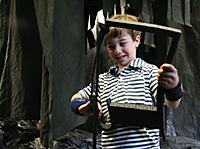By Leyna Krow, Assistant Editor, JTNews
Parents, teachers and young children gathered at the Stroum Jewish Community Center on Mercer Island on the evening of June 2 to celebrate a set of human experiences so commonplace that we often take them for granted — our emotions.
Through the course of the 2008-2009 school year, the Stroum JCC’s kindergarten class has been taking part in a pilot program called Roots of Empathy, which is designed to provide elementary-aged children with an accessible introduction to the complex world of their innermost wants and needs.
“The goal is for kids to get a perspective of other people’s emotions and to understand their own feelings as well,” said Dana Weiner, assistant executive director of development and outreach at the JCC.
Roots of Empathy was first developed in Canadian schools in the mid-1990s. It was introduced to the Seattle area for the first time as part of last spring’s Seeds of Compassion events and is being funded in several public and private schools in King County by the Kirlin Charitable Foundation and the John and Nancy Sabol Foundation.
The program, which began at the JCC’s kindergarten in the fall, brings parents of new babies and their infants into classrooms once a week for the duration of the school year to teach kids about emotions by watching the interactions between the pair.
JCC kindergarten teacher Shannon Cruzen explained that by observing the most basic emotions of children younger than themselves and discussing what they see, her students have become more aware of how they express their own feelings.
“The idea is that the baby is beginning to communicate its emotions even without talking,” she said.
Weiner said she’s been impressed by how quickly and with such depth the students have responded to the program. Teachers have presented the results at local educators’ conferences and the JCC is currently working with the Kirlin Foundation to find ways to get the program into more schools in the near future. The JCC plans to continue the program next year.
After seeing the initial success of the Roots of Empathy program among the kindergarten class, JCC educators decided to expand the curriculum to include a more creative element and to be accessible for kids in the preschool classes as well. The result was the Colors of Empathy project.
For Colors of Empathy, Cruzan explained, students were given opportunities to work with different colored materials and then asked to consider the emotions colors could evoke when used to represent different objects.
“We talked about how it might feel to be those things,” Cruzen said. “For example, we talked about what it would be like to be an orange flower and one kid said he would be scared of being picked if he were a flower. It’s really about providing a safe, comfortable space for the kids to start exploring their emotions and talking about them.”
Darci Lewis, the JCC’s early childhood education assistant director, said the Roots of Empathy program and the Colors of Empathy project fit with the Jewish education young children receive at the JCC.
“Judaism teaches that a whole range of emotions is okay. There’s not just one way to be,” she said. “That’s the way we’re approaching talking about emotions with the students.”
On June 2, the fruits of the JCC kindergarteners’ and preschoolers’ labors were on display for parents and friends to see. Installations of student color art and corresponding written descriptions covered the walls of the JCC’s foyer. Down the hall, an entire classroom was decorated in black as an example of a “color room,” of which the school made several throughout the year to give children the sense of being surrounded by a single color to provide a tangible experience for the color examples discussed in class.
Weiner said the displays on the JCC walls spoke to the success of the students at expressing an understanding of empathy.
“When you read some of the panels about how they express their emotions, it’s pretty introspective for this age group,” she said.
Of course, feelings don’t always have to be a serious matter. Inside “the black room,” pre-K student Aaron Herst didn’t appear particularly overwhelmed with the weight of personal introspection as he and a handful of other youngsters crawled through billowing crepe paper and pulled on Styrofoam shapes that hung from the ceiling.
When asked what feelings the room elicited for him, Herst smiled broadly.
“It’s fun in here,” he said.
